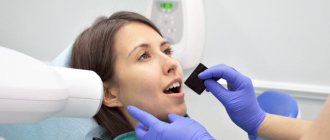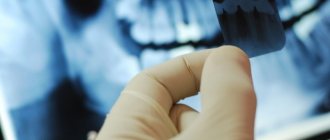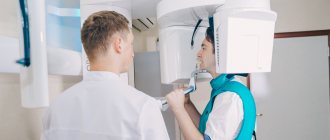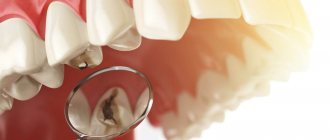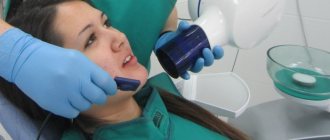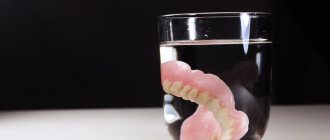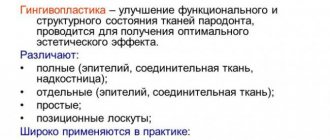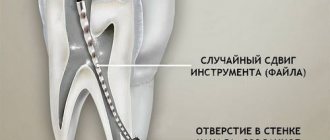From this article you will learn:
- how much does it cost to do a dental x-ray,
- what you need to know about radiation doses,
- Is it possible to take a dental photograph during pregnancy?
Dental X-ray is a traditional way to determine the quality of root canal filling, as well as to diagnose inflammation at the apex of the tooth root (with apical periodontitis). X-rays of human teeth in dentistry are most often carried out using targeted X-rays. A targeted photograph of a tooth received this name because it is small in size and shows the condition of only a few teeth and the bone tissue around them (Fig. 1-2).
Modern targeted X-rays produce a very low dose of X-ray radiation (compared to what it was 15-20 years ago). This is due both to the advent of ultra-sensitive photographic films, which require a significantly lower dose of radiation, and secondly, to the advent of special intraoral sensors that capture the image digitally and display it on a computer screen. Such digital images require several times less X-ray radiation - even compared to modern films.
Sighting and panoramic radiography in dentistry –
However, targeted images are not suitable for planning bite correction, assessing the condition of bone tissue before implantation, or planning the installation of future implants. They are not very convenient for planning treatment and prosthetics for a large number of teeth, and often do not allow detection of perforations and cracks in the tooth root. Focused photographs of the teeth may not be enough in cases where it is necessary to find problems with root canal filling in order to be able to properly treat the teeth.
Therefore, dentists very often refer patients to more complex options for x-ray examination of teeth and jaw bone tissue -
- dental computed tomography (CT),
- orthopantomogram (Fig. 3),
- teleroentgenogram (for bite correction).
In this article, we will go into detail about the pros and cons of targeted dental x-rays, and what you need to pay attention to if you need to have a dental x-ray (for your own safety). For detailed reviews on the remaining specified methods of radiography in dentistry, read the links above.
Sight image of a tooth –
A targeted photograph of a tooth can be recorded either on photographic film or using a special intraoral sensor that detects X-ray radiation and transmits the image to a computer screen (such a device is called a radiovisiograph or simply a visiograph - Fig. 5). In both cases, an X-ray machine is used as a radiation source (Fig. 4), i.e. the only difference is in the way the image is captured - either on X-ray film or using a digital sensor.
Taking an image using a visiograph -
Digital vs Film Photography: Pros and Cons
Targeted dental x-rays using film were once the only examination option in clinics. It must be said that film photographs have a number of disadvantages that have significantly reduced their use. They require expensive consumables (film, reagents), time to develop photographs, there are difficulties with storing photographs, and over time they fade and are lost. There are also differences in patient safety.
Even modern X-ray films require 4-8 times the radiation dose compared to digital X-ray sensors. For example, the radiation dose to a patient for 1 film image is 10-15 μSv (microsieverts), and for a picture on a visiograph it is on average 1-3 μSv (this dose corresponds to the background natural radiation received by each person in 1 day).
The patient's exposure time when using film X-ray is 0.5-1.2 seconds, and using a digital visiograph sensor - 0.05-0.3 seconds. It is precisely by reducing the required exposure time when using a radiovisiograph that the radiation dose is significantly reduced. Thus, in one day of treatment at the dentist you can take no more than 3 film photographs and 5-6 digital photographs. And as you will see below, the use of a visiograph in some cases even allows you to take an X-ray of a tooth during pregnancy, but in compliance with all safety rules and for urgent indications.
How to take a picture of a tooth using a visiograph: video
Important: always try to take digital photos and inform them in advance that you want them saved to a flash drive. Firstly, then you will always have the pictures at hand, and you can always show them to another doctor. Secondly, the photographs taken for control after treatment will be your guarantee that if you received poor-quality treatment, you will always be able to prove it (the clinic will no longer be able to lose your photographs and rewrite the medical record).
Thirdly, if a digital image is printed on a printer, then the quality of the image will depend not only on the quality of the digital image, but on the resolution of the printer (rare clinics have printers that print in high resolution). Therefore, a photo in digital format will have better quality than a photo printed on paper.
Dental X-ray machine and its types
At the moment, analogues for X-ray diagnostics have not yet been invented, so it is so important to choose high-quality equipment that will improve the quality of the clinic’s work.
Despite the wide range of X-ray equipment, experts still recommend choosing dental devices, since this type of equipment has higher power ratings.
For effective dental procedures and manipulations, digital devices are recommended, which have already been tested many times by doctors and patients in the dental field. This equipment provides quick acquisition of high-quality images of the dental cavity, which do not require development and can be stored in computer memory for decades. This is convenient, because any doctor, at a subsequent appointment, can trace a clear chronology of the treatment of a particular tooth.
It is worth understanding that such equipment has a relatively high pricing policy, but the technical and power parameters have no comparison. Requirements for diagnostic dental procedures are growing from year to year, which means that X-ray equipment must meet all these requirements.
Modern digital dental X-ray machines are represented by the following technology options.
Tomograph
Expensive equipment that allows for a comprehensive examination. Thanks to a computed tomograph, doctors have the opportunity to obtain a 3D image of the oral cavity with 100% quality, which indicates the trajectory of dental canals, hidden suppurations and much more. When paired, a conventional X-ray machine has only 40% clarity.
Using special software, doctors can obtain two-dimensional images that make it possible to treat perpendicular dental arches.
Using a dental tomograph eliminates the possibility of receiving erroneous data, which is not a joy with older X-ray machines.
It is important to remember that tomographs are expensive equipment, but the price may vary depending on the set of functionality.
Orthopantomograph
This equipment is designed to take clear and precise photographs of the tooth, dentition and jaw area.
The orthopantomograph images clearly show the presence of all fillings and difficult to recognize caries cavities, which often form in the cervical area, in the root area and on contact surfaces. The use of this technique allows the doctor to obtain a panoramic (overview) image, thanks to which an accurate diagnosis will be established and, if necessary, the forces of several dental specialists will be concentrated, who will be able to quickly solve the problems of the patient’s oral cavity.
Most analog orthopantomographs involve shooting on a special film, which subsequently undergoes a developing procedure. In this regard, this type of dental X-ray machine is in reduced demand among clinics.
Visiograph
This equipment is a complex of digital diagnostics. The use of visiographs is convenient, as it eliminates the need to develop photographic film and use various chemicals. This technique is popular because it has a low level of radioactivity and a high level of efficiency (about 95%).
The visiograph is used to identify complex forms of caries, pulpitis and periodontitis, as it allows you to identify microscopic abnormalities in the structure of the tooth. This undoubtedly affects the correctness of the diagnosis and subsequent treatment.
The modern dental equipment market provides a wide range of visiographs, both wired and wireless. The wireless version of equipment is in greatest demand, since, according to statistics, it lasts much longer than wired equipment. The wired device fails after 2-6 months.
Important! A dental X-ray machine must fully comply with the requirements of SanPiN, have licenses and all documentation.
When choosing a dental X-ray machine, we recommend purchasing equipment only from well-known brands and only through well-known channels. Poor quality technology does not provide a 100% guarantee of the safety of the patient and the doctor, and also reduces the effectiveness of the diagnosis, which negatively affects the diagnosis and subsequent treatment. Based on all possible risks, you should familiarize yourself in detail with the characteristics of the devices and not be greedy in material terms. The thousands saved will be spent after six months of operation of the X-ray machine on its repair and restoration.
Dental X-ray – price for 2022
The cost of one digital X-ray in Moscow will average from 250 to 350 rubles in different clinics. In addition, this price may only apply to a diagnostic initial image, while all other images taken during the treatment phase may cost less (about 150 rubles per image). Therefore, you should carefully read the clinic’s price list.
It should also be noted that there are a large number of clinics in which the cost of dental treatment is indicated on an all-inclusive basis. Accordingly, the cost of treating your tooth will already include the required number of x-rays (usually 2-4 pictures), for which you will no longer pay anything extra.
What else you need to pay attention to is that the price list of some clinics may state that the cost of a targeted x-ray indicated on the clinic’s website applies only if you are a patient of this clinic. Therefore, if an image is taken to be submitted to another clinic, its cost may be 100 rubles higher).
In addition, if you need a printout of a digital image, some clinics may also charge you about 50 rubles for this. The same applies to the description of the x-ray image: if you want to receive a written description of the image taken by a radiologist, then in some clinics they may additionally ask you for about 100-150 rubles.
Radiation doses and safety –
A patient's radiation exposure is measured in either microsieverts (µSv) or millisieverts (mSv). The recommended radiation dose for the population received as a result of X-ray studies (according to the recommendations of SanPiN 2.6.1.1192-03) should not be more than 1000 μSv per year (= 1 mSv per year).
Below we will give examples of different types of images in dentistry and the corresponding radiation exposure to the patient (data from the Ministry of Health of Russia dated July 22, 2011 and December 21, 2012)…
- Targeted images on a digital radiovisiograph – → lower jaw in adults – 2 μSv, → lower jaw in children under 15 years old – 1 μSv, → upper jaw in adults – 5 μSv, → upper jaw in children under 15 years old – 3 μSv.
- Sight shots using film – 10-15 µSv.
- Digital panoramic image – 55 µSv, but if the patient is less than 15 years old – 24 µSv.
- Digital teleroentgenogram – 7 µSv.
Conclusions: thus, targeted images using a radiovisiograph provide the lowest radiation dose compared to other types of x-ray examination in dentistry. During one visit to the dentist, you can take 5-6 pictures on a digital radiovisiograph without risk to health, but no more than 100 such pictures during the year. A digital orthopantomogram (panoramic x-ray of the jaw) can be done 1-2 times a month, but no more than 10 times during the year. Panoramic films on film provide a greater radiation dose to the patient, and they can be taken less frequently than digital ones.
Service and repair of dental x-ray equipment and equipment
Dental x-ray equipment
, regardless of cost, wears out over the course of its service life, requires maintenance or fails.
If malfunctions or signs of malfunctions or deviations from the norm are detected, it is necessary to apply for diagnostics and repair of X-ray equipment in a timely manner in order to resolve the problems in the shortest possible time in order to avoid situations that may endanger the health of patients and doctors.
The service package for equipment maintenance must be regular.
The frequency of service work is established by the relevant documentation and depends on the manufacturer’s recommendations and on the exhaustion of the equipment’s service life.
Is it possible to take a dental x-ray during pregnancy?
Is it possible to take a photograph of a tooth during pregnancy? This issue is regulated by the recommendations of SanPiN 2.6.1.1192-03. These recommendations do not prohibit taking dental x-rays during pregnancy, but it is strongly recommended to use x-rays only in truly necessary cases, for example, in case of acute pain and the provision of appropriate emergency care.
It should be noted that over the past 20 years, the radiation doses received by patients with 1 x-ray of the teeth have become tens of times less, thanks to the advent of radiovisiographs and ultra-sensitive photographic films, which require significantly lower x-ray radiation (24stoma.ru). Therefore, the risks of fetal pathologies have decreased significantly in recent years.
Of course, if possible, X-ray examination of teeth should be avoided, but there is nothing terrible about this today, because The radiation dose of 1 image on a radiovisiograph is approximately equal to the radiation dose of any person to natural background radiation in 1 day. In addition, the irradiation time on the visiograph will be only 0.05-0.3 seconds, which, if protective measures are observed (lead apron), can significantly increase the safety of the procedure.
Additionally, it is worth considering the following recommendations –
It is better not to do a dental x-ray during pregnancy in the early stages, because at this most important time for the laying of organs and tissues of the fetus. And if x-rays are taken, then it is in the second half of pregnancy, because the risks to the fetus during this period are significantly reduced. Please note that you can only take pictures using a modern digital radiovisiograph of the latest generation, because Their radiation dosages are significantly lower than those of outdated digital radiovisiographs and, even more so, film devices.
The most popular models of targeted X-rays
Rextar
Dental X-ray machine Rextar - X (RT-1010 / Rextar LCD) from the South Korean brand Poskom is a model of a portable high-frequency device.
High-precision, ergonomic Rextar-X always guarantees:
- ideal image quality due to the generated radiation;
- ideal protection from radiation (even in minimal doses) thanks to the lead plates from which the device body is made;
- no need to use additional protection;
- the ability to take pictures taking into account the correct exposure;
- bright lighting - the presence of an LED display greatly facilitates the work process;
- the ability to work while simultaneously holding the device in your hands, since the weight and size of the device are minimal - which means that the dentist will not need an assistant.
Lightweight, high-precision, convenient and safe X-ray machine Rextar - X, which, among other things, can be equipped with a tripod and control panel.
Rextar is one of the most practical and convenient modern models of portable X-ray machines for dentistry!
Targeted dental images using Rextar-X are distinguished by the highest resolution, which always contributes to an accurate result and a favorable treatment outcome.
The conclusion is obvious: dental X-rays using Rextar - X are the most reliable way to quickly and accurately diagnose teeth and the oral cavity.
How much does Rextar cost - X
The price of Rextar - X is slightly different from the prices of other models of portable X-ray machines. And naturally, the question arises: is it worth overpaying?
If you want to buy an X-ray machine for daily use, and expect 100% return: reliability, speed, high quality panoramic images, guaranteed service life and other objective advantages of a modern high-quality X-ray machine, then you are unlikely to be confused by the price , which pays for itself in a matter of months.
How to quickly and efficiently take a targeted photograph of a tooth using other X-ray machines, how much do they cost and which X-ray diagnostic device in dentistry is next to Rextar - X?
PROX
PROX is a portable X-ray machine from DigiMed (Korea), highly technical, compact, and ergonomic.
The PROX X-ray machine is designed for dentists and dental technicians to use as an extraoral source of X-ray radiation. PROX provides excellent diagnostic and x-ray imaging with both intraoral image receivers and film. PROX is used in the diagnosis of adults and children.
The advantages of PROX also include low weight and size, complementability with a tripod, wall arm and control panel.
FONA XDG, X70, XDC
Italian X-ray machines FONA are another series of high-tech equipment for dentistry, thanks to which precise images are obtained that satisfy the rather strict approach of specialists to quality.
Dental X-rays with the FONA XDG, a wall-mounted or stand-mounted unit, involve not only the use of high-resolution digital image receivers, but also fine-grained films.
FONA X70 and FONA XDC are classic X-ray machines designed to resolve always pressing issues in dentistry. Work with conventional X-ray films and digital sensors. FONA X-rays are available on the wall or on a stand.
Analysis of targeted dental images –
Analyzing X-rays is not difficult if they are of good quality.
Almost any patient will be able to see signs of periodontitis or cysts in the image, and will also be able to determine how well his root canals are filled. All you need here is skill. But it is worth remembering that absolutely everything cannot be diagnosed using X-rays, for example, inflammation of the nerve of a tooth. You can diagnose from the image -
- caries (but not in full),
- periodontitis (granulomas, cysts),
- quality of root canal filling after treatment of pulpitis and periodontitis,
- perforations and root cracks,
- fragments of instruments in root canals,
- presence of periodontal pockets...
1) A group of images indicating the development of inflammation (periodontitis) at the apexes of the roots of previously untreated teeth. In this case, you will always see a clear or vague darkening at the apex of the tooth root, which can be of different sizes and shapes.
2) A group of photographs taken after root canal filling. The first 2 pictures (Fig. 14-15) show what well-filled root canals look like. The following images show poor quality treatment and complications that arose (read the descriptions in each image).
Summary: important points
As a practicing dentist who knows the system from the inside, I want to draw your attention to the following points that are important for your safety. If the clinic has an X-ray machine, then a license must be obtained for it, the issuance of which presupposes the mandatory presence of a certified radiologist on the staff of the dental clinic. However, in reality, even in large clinics and public clinics, it is not always the case that x-rays will be taken by a trained specialist.
Even if he is, he may go on vacation or get sick, and a regular nurse (dental assistant) will take the pictures instead. This is a gross violation that leads to both the production of low-quality images and an increase in the radiation dose. In small clinics, the risks of receiving a poor-quality x-ray examination are much higher, and the first thing that makes you suspect a forgery is if the picture is taken not by a special employee, but by a nurse from the dentist you came to see.
The second very important point: if you see that the x-ray is not done in a special room, but the x-ray machine is located right next to the dentist’s chair, then you should change the clinic and the doctor. The fact is that all objects in this office (including the dental chair and doctor’s instruments) will have an increased background radiation, and this is no longer safe for health. We hope that our article on the topic: X-ray of the jaw and teeth was useful to you!
Sources:
1. Higher prof. the author’s education in therapeutic and surgical dentistry, 2. Based on personal experience in therapeutic and surgical dentistry, 3. National Library of Medicine (USA), 4. “Digital and film radiography in outpatient dentistry” (Chibisova), 5. “X-ray diagnostics in dentistry" (Lutskaya I.K.).
What is a dental orthopantomograph, how safe is it?
Our dental clinic has a panoramic digital orthopantomograph OP100D, manufactured by Instrumentarium Imaging, Finland. allowing you to obtain high-resolution images with maximum convenience for the patient. When examining patients using a new orthopantomograph, the dose of ionizing radiation is 90% (!) less than when examining using traditional devices. It achieves excellent image quality through the use of panoramic dental X-ray equipment, which has a number of excellent features. With the OP100D, lateral and posteroanterior images of the temporomandibular joint can be obtained separately, which can even be combined on the same film.
Panoramic photographs taken using an orthopantomograph provide flawless images. The OP100D automatically controls the exposure value by detecting the amount of radiation received by the film cassette and adjusting the exposure settings according to the patient's bone density. In the manual exposure control mode, the user can control the exposure himself, either by pre-programming simple graphic symbols, or by completely manually selecting exposure values. A digital modification of the OP100D orthopantomograph allows for 3D image reconstruction.
What is a pantomograph?
A pantomograph (from the Greek “pan” - all + tomography) is an X-ray device for panoramic imaging of the entire jaw area and jaw joints. A panoramic image displays a detailed image of the jaws and all teeth. The use of panoramic images is provided for by international treatment standards, which recommend conducting such a study annually. Therefore, a pantomograph is a necessary device for a modern dental clinic.
What is the correct name for an orthopantomograph?
Many sales offers from different manufacturers have given rise to variant names: o Orthopantomograph. o Pantomograph, o Panoramic X-ray machine, o Panoramic X-ray machine. o Panorampik. All these names are equal. The official name of this class of devices is “pantomograph”. In dental practice, the term “orthopantomograph” is often used (from the name of the first panoramic device - Orthopantomograph).
What additional equipment is needed for a pantomograph?
There are two types of pantomographs: film and digital. Film pantomographs require a darkroom. Creation and maintenance of darkrooms requires considerable costs. But film pantomographs themselves are much cheaper than digital models. It should be noted that according to Russian regulations (in particular, SanPiN), placing photo laboratories in residential buildings is prohibited. Digital pantomographs require a computer. They do not need expensive consumables, so in the end digital devices turn out to be a more profitable purchase. Digital panoramic devices make it possible to reduce the radiation dose to patients by 2-3 times compared to film devices and immediately display the examination results on a computer monitor (bypassing the film processing stage). Pantomographs can be additionally equipped with a device for cephalometry (cephalostat). The cephalostat allows you to obtain a frontal profile image of the skull, which is necessary for orthodontists to build orthodontic structures.
How does a pantomograph work?
The operating principle of orthopantomographs is that the X-ray emitter and the film cassette move in concert around the patient’s head. In this case, the image produces a flat image of a curved object (jaw or skull).
What shooting programs are used in pantomographs?
Typically, work (in 90% of all studies) uses a standard survey survey program, which is available in all models of pantomographs. However, there are many additional shooting programs that depend on the specific model of the panoramic camera. These programs include separate images for the upper and lower jaws, images of the maxillary sinuses, programs for photographing children, a program for 1.25 times magnification, etc.
Can a pantomograph be used directly in a dentist's office?
You can. New SanPiN 2.6.1.802-99 “Ionizing irradiation, radiation safety” allows you to place “dental devices and pantomographs working with a highly sensitive image receiver (without a darkroom) and dental devices with digital image processing” in the premises of a “dental institution located in a residential building , including in those adjacent to residential premises, subject to the requirements of radiation safety standards for the population within the premises in which X-ray examinations are carried out.”
What kind of computer is required for a digital pantomograph?
Any computer of the Pentium class or higher is suitable for the pantomograph. Special requirements apply to the monitor. A good image is obtained on monitors with a diagonal of at least 17″.
Why does a pantomograph need a computer network?
The computer network allows the dentist to see the image at his workplace as soon as it is taken in the X-ray room.
If you find an error, please select a piece of text and hold LEFT Ctrl and press Enter.
You can send no more than 5 messages in 30 minutes!
Liked? Tell your friends!
